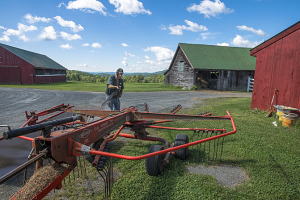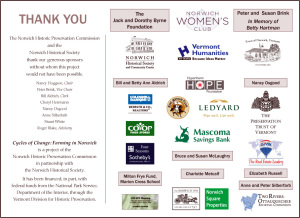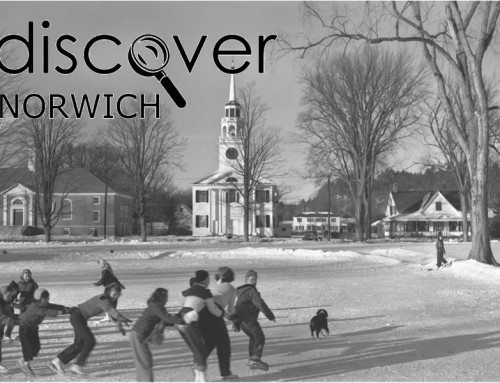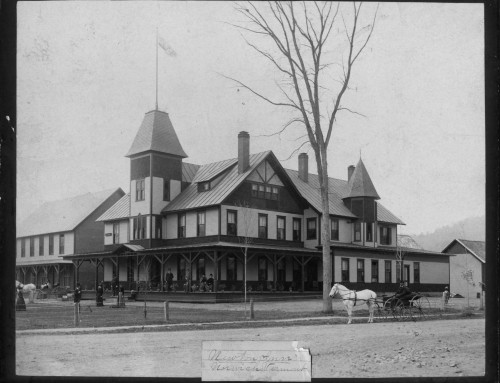A story of our rich agricultural heritage
 Cycles of Change: Farming in Norwich was a project of the Norwich Historic Preservation Commission in collaboration with the Norwich Historical Society. The exhibit, on display at the Historical Society in 2014-15, featured the stories of eight current-day working farms through Chad Finer’s photographs, a series of Vermont Folklife Center oral history interviews with each of the farmers, and a video by Ben Silberfarb.
Cycles of Change: Farming in Norwich was a project of the Norwich Historic Preservation Commission in collaboration with the Norwich Historical Society. The exhibit, on display at the Historical Society in 2014-15, featured the stories of eight current-day working farms through Chad Finer’s photographs, a series of Vermont Folklife Center oral history interviews with each of the farmers, and a video by Ben Silberfarb.
Photography: Chad Finer
Video: Ben Silberfarb
Research and Writing: Charlotte Barrett Alan Berolzheimer Seth Goodwin
Oral Histories: Vermont Folklife Center, Middlebury, Vermont

The project was funded, in part, by a grant from the Vermont Division for Historic Preservation and the National Park Service.
Cycles of Change: Farming In Norwich from Ben Silberfarb on Vimeo.
A story of our rich agricultural heritage
According to the U.S. Department of Agriculture, between 2007 and 2012, the number of farms in Vermont increased for the first time in 150 years. Despite the financial risks and physical demands, more people in this small state are choosing to become farmers.
Vermont has become a national model for small-scale, sustainable agriculture. The state’s commitment to strengthening its food system, evident in innovative legislation such as the Farm to Plate Investment Program (2009), sends a clear pledge of support to farmers. Statewide organizations like the Northeast Organic Farming Association and the Vermont Land Trust, along with countless local programs, work with farmers and food-related entrepreneurs to find the resources they need to be successful. The result: more land in agricultural production, more women and minor- ity farmers, and a 15% increase in the market value of Vermont products. Developing the farm and food sector creates a robust economy and puts healthy food on our tables.
The eight farms featured in this exhibit represent the diversity of agricultural enterprise in Norwich. Whether raising meat animals, grow- ing organic vegetables, cutting hay, or making compost, these farmers share a commitment to high quality, nutritious food. They are creative in the face of an ever-fickle economy and resilient in the face of unpredictable weather. They are conservationists without the title, preserving open space, soil quality, and wildlife habitat. And they are agents of community—trading advice with each other, inviting us to invest in their farms through Community Supported Agriculture programs (CSAs), and giving us a reason to step out of busy lives to mingle with neighbors at farmer’s markets.
Cycles of Change is a project of the Norwich Historic Preservation Commission, in collaboration with the Norwich Historical Society, the Norwich Public Library, and the Marion Cross School. Through a series of public and school programs and a community-wide forum, it will examine the vital role that farms continue to play in town life, the challenges they face, and how state and local policies and regulations help and hinder them. The 15-minute video is available for loan.
Cycles of Change: Farming in Norwich: A Chronology
Introduction
The history of farming in Norwich dates back to the town’s founding in 1761. As with many Vermont towns the vitality of farming in Norwich waxed and waned depending upon finances, competition, the price of land, and issues associated with economies of scale. Consistent throughout the entire story is the tenacity, resilience, and dedication of individual Norwich farmers who believed deeply in the necessity of agriculture. These farmers have remained a central part of this community since the 18th century, and they fuel the local food and agriculture resurgence we see in town today.
1761-1800
1761: Prior to the arrival of Norwich’s first European American settlers, Abenaki people made the Connecticut River valley their home for millennia. The early settlers probably encountered small Abenaki villages, burial grounds, and agricultural plots.
[1] They also faced the overwhelming task of carving out living spaces from massive forests. Their goals were simply survival and subsistence, but their resolve was impressive.
1768-1772: The Burtons, a founding family of Norwich, cleared and planted three acres of land by 1768 where Fairview Cemetery is located on Beaver Meadow Road.[2] By 1772 more than sixty acres of land had been opened in the center of present-day Norwich village.[3]
1800: Wheat grew well in this new soil and became a bumper crop – forty bushels to an acre. It was even used as a form of currency at the Olcott Store in town where customers could pay their bills with bushels of the valuable grain.[4] But without the concerted use of fertilizers or crop rotation the soil was quickly depleted. Eighteenth century Norwich settlers “mined, rather than cultivated” the land.[5]
1800-1850
1811: The first merino sheep were introduced to Vermont in 1811. They were well suited to the landscape and their numbers peaked by the mid-1830s.[6]
1828: An invasion of the wheat midge severely damaged crops throughout the state and hastened the decline of wheat farming and the transition to sheep.[7]
1840: In Norwich alone, 13,400 sheep roamed the valleys and hillsides.[8] Sheep farming occupies a storied place in Vermont’s agricultural history, but it was a relatively short-lived moment. The sheep market was susceptible to pricing instabilities and competition. Protective tariffs that had previously spiked wool prices were removed in 1840.[9] Prices dropped as Australian wool entered the U.S. market along with a flood of wool from Western producers.[10]
1850: Sheep farming was able to hang on for a time in Norwich. In 1850, 183 of the town’s 250 farmers had about 10,000 sheep. Dairy farming was also emerging, and Norwich had 11 dairy farmers with 10 cows per farm in 1850.[11]
1850-1900
1861-1865: The interruption of the Civil War was good for sheep farming. Wartime demand was driven by the need to clothe the Union Army in wool uniforms when Southern cotton was unavailable. After the war, however, the decline in sheep farming continued. Agricultural specialization also emerged during this period. For example, Vermont apples became a staple for Union troops during the Civil War.[12]
1884: Strawberries were grown in the Connecticut River valley. The delicate berries, previously impossible to safely transport, now arrived in Boston by railroad. Norwich farmers grew one thousand bushels in 1884 with an estimated market value of $3,000.[13]
1885-1890: Profitability from dairying was unpredictable because transporting milk long distances risked spoilage. The refrigerated railroad car dramatically increased access to distant markets. Shipping locations sprung up across Vermont to take advantage of the lucrative Boston and New York markets – areas beyond the competitive reach of milk from the West.[14]
In 1888, the Norwich Creamery was founded. It was sold in 1904 to Hood & Company, which operated a creamery near the railroad in Lewiston.[15] Local dairy farmers now had direct access to Boston and New York. Profitability was widespread and half of all Vermont farmers earned the majority of their living from dairy farming in 1900. However, profits continued to fluctuate as large urban buyers set prices and thus controlled the fortunes of Vermont farmers.[16]
1890: The last census year in which sheep outnumbered people in the state: the human population was 332,422, and sheep numbered 333,947.[17]
1900-1950
1900: Farming still employed a plurality of Vermonters with 37% of families earning their incomes from agriculture.[18]
1930: The total number of farms declined from 33,000 in 1900 to 25,000 in 1930. Broader demographics were also shifting as primary employment in 1930 shifted from agriculture (27%) to industry (28%).[19]
1930-1950: From the 1930s onward, dairy farming became an increasingly unpredictable endeavor. Although Vermont supplied Boston with about 85% of its milk during the 1930s, prices destabilized due to surpluses, declining demand and efficiency problems that undermined profits.[20] Farmers also experienced economic strain from rising taxes, increased land values, and greater competition from Western milk producers.
By 1950, Vermont had only half of the farms it had in 1890.[21] In Norwich, the number of farmers in 1950 hovered around 40.[22]
1950-2000
1950s and 1960s: Throughout these decades pressures increased on Vermont farmers. The arrival, and expense, of stainless steel bulk tanks was a burden for many Vermont farms and their numbers dwindled from 6,900 in 1962 to 4,153 in the early 1970s.[23] Closer to home, in 1960, 5.4% of Norwich residents identified themselves as farmers. Six years later, in a town questionnaire, there were 22 self-identified farmers in town – 4.8% of the Norwich population.[24]
Beginning in the mid-1960s, Vermont became a counter-cultural focal point and more people arrived to pursue self-sufficient lives in the isolated hills and valleys. The construction of Interstates 89 and 91 facilitated in-migration during this decade.[25] To some extent, these newcomers were responsible for jump-starting farming trends that focused on high-output crops such as vegetables and fruits.[26] This was, in part, the beginning of the new food movement that has continued until today.
1970s: Despite strong interest in new food systems, farming in Vermont remained a risky enterprise. Financial pressures, highly competitive markets, increasing land values, and factors associated with economies of scale drove more farmers out of business or into consolidation. The consolidated farms, however, were often larger and more productive. The total value of Vermont’s agricultural products rose sharply: $136 million in 1969; $207 million in 1974; and $274 million in 1978.[27]
1971: The Northeast Organic Farming Association of Vermont (NOFA) was founded to support an increasingly vibrant local food market throughout the state. (Today, with the help of NOFA and other organizations, more than 580 farms and processors in Vermont are certified as organic under USDA standards.)[28]
1971
The Northeast Organic Farming Association of Vermont (NOFA) is a nonprofit association of farmers, gardeners, and consumers working to promote an economically viable and ecologically sound Vermont food system for the benefit of current and future generations. There are over 1300 members throughout the state and 580 farms and processors are certified as organic, according to the USDA National Organic Program Standards.
1973: Small-scale agriculture remained challenging, and farmers in Norwich dwindled even further. According to data from a 1973 town questionnaire, 12 people identified themselves as farmers – 2% of Norwich’s population at the time.[29]
1974: A state Commission on Food was created to address the issue of farm closures. It made a number of farsighted recommendations, one of which emphasized the importance of farmer’s markets and cooperatives.[30] The Norwich Farmer’s Market, founded in 1977, was one of the first in the state.
1975
Because of concerns stemming in part from the impact of the OPEC oil embargo on the cost of food, then Governor Thomas Salmon created the Emergency Commission on Food, which warned of a unique “emergency in terms of the supply and the price of food.” Among the commission’s charges were to “develop programs and policies which will provide an adequate supply of food for Vermont residents at reasonable and justifiable prices.”
1976
The report from the Governor’s Commission on Food offered wide-ranging recommendations from support for food cooperatives and farmers’ markets to the development of economic models showing the impact of agricultural activities on Vermont’s economy to encouraging development of specialty cheeses.
1977
The Norwich Farmer’s Market was one of the first in the state.
1978: Rapidly increasing land values created unaffordable property taxes for many Vermont farmers. The Use Value Appraisal program (also called “Current Use”) was passed by the legislature in 1978. The new law allowed farm and forest lands to be taxed on use, rather than market value. Across the state there are currently 17,000 properties enrolled in the Current Use program totaling 2.3 million acres – approximately 33% of Vermont’s total land area.[31] In Norwich, there are currently 141 parcels of land totaling 12,999 acres enrolled in the Current Use program, most of which is forest.[32]
1980s: By 1980, open farmland in Norwich amounted to 3,549 acres in a town of 28,608 acres. In contrast, Norwich had 7,703 acres of open farmland in 1939.[33]
Milk prices wavered due to overproduction and declining consumption. Price supports intended to bolster the profits of New England dairy farmers faced significant opposition from Midwestern and Western farmers. By the end of the 1980s an additional 7% of Vermont’s dairy farms had succumbed.[34] Norwich reflected this downward trend with only two dairy farms in 1986.[35]
1982: The total value of Vermont’s agricultural products was $369 million.[36]
1990s: Diversification, always an underlying theme in Vermont farming history, reappeared as farmers considered the path forward in the 1990s. Veteran dairy farmers saw opportunities in organic milk and premium dairy products. Vegetable, fruit, and meat producers tapped into consumer interest in sustainability, locally grown organic vegetables, free-range meats, and value-added farm products of all kinds. They found outlets in organic food sections in supermarkets, Community Supported Agriculture (CSA), and the ever-popular farmer’s markets. These trends were the forerunners of the reinvigorated farming economy that we see today in Norwich.
1997: The Vermont Fresh Network was created in 1997 as a partnership between the New England Culinary Institute (NECI) and the Vermont Department of Agriculture, successfully connecting farms to restaurants.[37]
1997
The Vermont Fresh Network, a partnership between the New England Culinary Institute and the VT Department of Agriculture, encourages farmers, food producers and chefs to work directly with each other to build partnerships. Building these regional connections contributes to stronger local communities and their economies.
2000 to Present
Collaboration, innovation, community support, organics, sustainability, and creative financing were the hallmarks of the last 14 years in Vermont agriculture.
2009: Farm to Plate Gets Underway
The Farm to Plate Investment Program, approved by the Vermont legislature in 2009, tasked the Vermont Sustainable Jobs Fund with crafting the Farm to Plate Strategic Plan in order to reflect the growing movement in sustainable agriculture—involving increased local food production and consumption, value-added processing, and diversified farms. The outcomes of the 10 year strategic plan are to “increase economic development in the state’s food and farm sectors, create jobs in the food and farm economy, and improve access to local foods.” The plan went into effect in 2011 and data shows that the farm and food sector in Vermont has grown, adding more than 3,600 jobs between 2009 – 2013.[38] Today, the Farm to Plate Network, with its 300+ organizational members is making great progress in implementing the 25 goals of the plan and is well on its way of doubling the amount of locally produced food consumed by Vermonters.
2012: Interesting trends appeared in the 2012 USDA Census of Agriculture for Vermont.
- The market value of Vermont’s agricultural products increased from $673 million in 2007 to $776 million in 2012.
- Between 2007 and 2012 the total number of Vermont farms increased from 6,984 to 7,338.
- Dairy farms decreased, but there was growth in small-scale farms with acreage between 10 and 49 acres.
- The number of Vermont farmers between the ages of 25 and 34 increased by 22% since 2007.
- More than 20% of the principal farm operators in the state are women.[39]
Conclusion
Encouraging developments continue. The Vermont Higher Education Food Systems Consortium was established in November 2013 between multiple Vermont colleges with the goal of educating the next generation of agricultural experts to improve and expand the state’s food systems.
The Vermont Higher Education Food Systems Consortium (University of Vermont, VT State Colleges, Sterling College, Green Mountain College, Vermont Law School, Vermont Technical College and Middlebury College), established in 2013, is making agriculture, food systems and the working landscape key development priority areas. They are designing new ways to collaborate, share students and resources and expand elective opportunities for place-based food systems education where “Vermont is our classroom.”
Closer to home, one need only spend an hour or two on any given Saturday from May to October at the Norwich Farmer’s Market, or visit any one of the farms featured in this exhibit, to know that something remarkable is happening in Norwich and across Vermont as we move food from farm to table in more and more creative and sustaining ways.
Notes[1]
[1] Alan Berolzheimer, “The History of Farming in Norwich”, The Norwich Times, Winter/Spring 2014, 6-7.
[2] Norwich Bicentennial Committee, Norwich, VT, Some Pages of Norwich History: A Bicentennial Publication (Norwich, VT: 1961), 21.
[3] Norwich Bicentennial Committee, 23.
[4] Ibid., 27.
[5] The Norwich Woman’s Club, “Know Your Town”; the 1940 Survey of Norwich, Vermont (Norwich, VT: The Norwich Woman’s Club, 1942),12-13.
[6] Michael Sherman, Gene Sessions, and P. Jeffrey Potash, Freedom and Unity: A History of Vermont (Barre, VT: Vermont Historical Society, 2004), 170-171; 232.
[7] Ibid., 172.
[8] Norwich History Book Committee, Norwich, Vermont: A History (Norwich, VT: Norwich Historical Society, 2012), 111.
[9] Sherman, Sessions and Potash, 172.
[10] David Lindahl, “Finding Vermont’s Farmlands: in the Woods Or Beneath the Streets: Development and Farmland Loss in Norwich, Vermont: 1939 to 1986” (Honors Thesis, Dartmouth College, 1987), 10.
[11] Norwich History Book Committee, 111.
[12] Sherman, Sessions and Potash, 234.
[13] M. E. Goddard and Henry V. Partridge, A History of Norwich, Vermont (Hanover, NH: Dartmouth Press, 1905), 155.
[14] Sherman, Sessions and Potash, 408.
[15] Norwich History Book Committee, 123; Margaret McNally Cheney and Frances L. Niles. Norwich. Images of America (Charleston, SC: Arcadia, 1998), 66; Goddard and Partridge, 145.
[16] Sherman, Sessions and Potash, 408.
[17] Ibid., 232.
[18] Ibid., 407-408
[19] Ibid.
[20] Ibid., 461.
[21] Ibid., 516.
[22] Town Report, Norwich, Vermont, 1950.
[23] Sherman, Sessions and Potash, 517.
[24] Report on the Comprehensive Plan for Norwich, Vermont, August 1967, 20, 3, 15.
[25] Sherman, Sessions and Potash, 524.
[26] Lindahl, 18.
[27] 1969 Census of Agriculture, Volume 1, Area Reports, Part 3, Vermont; 1974 Census of Agriculture, Volume 1, State and County Data, Part 45, Vermont; 1978 Census of Agriculture, Volume 1, State and County Data, Part 45, Vermont.
[28] “About NOFA Vermont,” Northeast Organic Farming Association of Vermont, accessed April 2, 2014, http://nofavt.org/about.
[29] Norwich, Vermont, 1973-1972, Reports of Town Planning Committees, March 1974, A12
[30] Sherman, Sessions and Potash, 564.
[31] “Current Use,” Vermont Department of Taxes, accessed April 2, 2014, http://www.state.vt.us/tax/pvrcurrentuse.shtml.
[32] Phil Dechert and Jonathan Bynum in email correspondence, April 1, 2014.
[33] Lindahl, 51-52; Norwich acreage total from communication with Phil Dechert and sourced from the U.S. Census Bureau.
[34] Sherman, Sessions and Potash, 566.
[35] Lindahl, 69.
[36] 1982 Census of Agriculture, Volume 1, Geographic Area Series, Part 45, Vermont.
[37] Sherman, Sessions and Potash, 568-56.
[38] “Farm to Plate: From Plan to Reality?, VT Edition, VPR Vermont Public Radio (Norwich, VT: WNCH. Jan. 21, 2014). Food system jobs expanded by 2,162 net new jobs according to VT DOL between 2009 – 2nd Q 2013 + 1,453 new farm operator and farm worker jobs, according to the 2012 USDA Census of Agriculture.
[39] Editorial, “Up on the Farm,” Valley News (White River Jct., VT), Feb. 25, 2014, A6.
Valley News editorial – February 25
“Vermont has worked hard over the past several decades not only to preserve cherished farmland but also to cultivate a thriving local and sustainable agriculture movement that encourages the production and sale of locally grown food. The Farm to Plate Strategic Plan, which won legislative approval in 2009, for example, seeks to increase economic development in Vermont’s food and farm sector; create jobs in the food and farm economy; and improve access to local foods.
Both this and other legislative initiatives, as well as many compatible nonprofit and community efforts, appear to be bearing fruit. According to the most recent annual report of the Farm to Plate program, food manufacturing in Vermont has grown since 2009, as have other food-related jobs. Farm and food workers are helping to advance Vermont’s community-based food networks and agricultural economy, preserving the landscape in the process. Success in this area is likely to breed success, as more and more famers and food entrepreneurs come to regard Vermont as fertile ground.”






